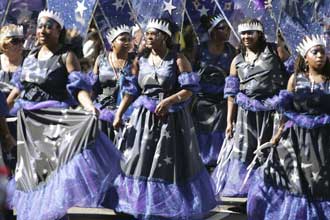 General
General
Scottish country dances are categorised as reels (including hornpipes), jigs, and strathspeys according to the type of music to which they are danced. The first two types (also called quick-time dances) feature fast tempos, quick movements, and a lively feel. The third type (strathspey) has a much slower tempo and a more formal, stately feel. There are also 9/8 jigs, minuets and waltz-time dances although they make up a very small part of the repertoire.
Dancers and Sets
Scottish country dancing is generally done in organized formations referred to as "sets". Sets usually consist of three or four couples, but some dances call for larger sets of five, six or even more couples. Couples are normally mixed, but women will dance with women or men with men depending on the make-up of the assembly.
Phrasing and formations
Scottish country dances are made up of figures of varying length, to suit the phrasing of Scottish country dance tunes. For the most part, figures are 2, 4, or 8 bars of music long; there has been some experimentation going on with unusually phrased music (e.g., 6-bar or 10-bar phrases) but the custom has not caught on. There are various kinds of figures ranging from the very simple (like a couple changing places across the set giving right hands) to fairly intricate evolutions involving three or four couples at the same time. These figures are combined to form a sequence of (normally) 32 bars---there are dances which are as short as 16 bars or as long as 64 bars. This sequence is then repeated several (often 8) times to form the complete dance.
Steps and Technique
Unlike ceilidh dancing or English country dancing, which are mostly done using walking steps, Scottish country dancing calls for special footwork according to a dance's choreography. Travelling steps include the skip-change of step in quick-time dances and the Strathspey travelling step in strathspey time, while setting steps include the pas de basque in quick time and the common schottische or Strathspey setting step in strathspey time. Some dances also involve special setting steps from Highland dancing, such as the rocking step, high cuts, or Highland schottische. In quick time, there is also the slip step for quick sideways movement, e.g., in circles.
A much more important aspect of good SCD technique than footwork has to do with space and time, i.e., ensuring that one is at the proper location at the proper time. It is vital not to stand in other dancers' way as well as to be in place in time for the various formations involving several dancers or couples. "Phrasing" means to execute a figure appropriately timed to the music, while "covering" means for several dancers to move in unison, forming split-second lines, squares etc. Many SCD groups like putting on "demonstrations" showing near-to-perfect dancing involving all aspects of technique.
Finally, SCD is social dancing. Hence interaction with one's partner and the other dancers, such as smiling and giving hands, is an essential part of SCD, and for those who want to there are usually lots of opportunity for relaxed "flirting". Progression
Most Scottish country dances are "progressive", i.e., after one repetition of the figure sequence the couples end up in a different place in the set. This serves to let every couple have a go as "top couple" (most active), and the number of repetitions is adjusted accordingly.
In fact, the figures and arrangement of modern Scottish country dances, while derived from a 300-year tradition, make it difficult to generalize because many dances feature unusual ideas such as partner changes (you get a new partner on every new turn of the dance, as in "Nighean Donn" (The Brown-Haired Girl), by Peter Hastings, or "Caddam Wood" by John Mitchell), palindromic structure (the sequence of figures is similar seen from the end to the beginning as it is seen from the beginning to the end), fugues (the sequence of figures for each couple is intricately intertwined to resemble the structure of a musical fugue) and others. Hamilton House seems very unusual. It is very entertaining for dance devisers to "play" with the tradition and to try new ideas, although the results do not always seem to catch on!
点击查看本频道更多精彩内容